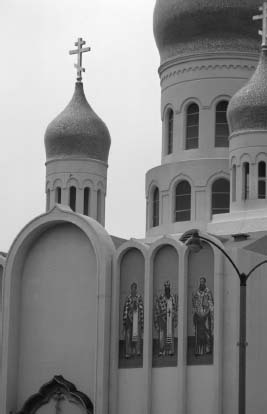ChristianitySigns and Symbols |
Do Christians mark their sacred spaces with any distinctive signs and symbols? |
Christian places of worship, generally called churches, almost always have one immediately identifiable feature—namely, a cross. Eastern churches often display a cross with distinctive short (sometimes slanted) bars above and below the main horizontal crossbar. Many also have one or more spires that have traditionally held the church’s bells. Although the bells of most churches rarely mark all the hours of the day as they once did, some communities still mark the beginning of services by tolling them.
Church designs today are remarkably varied. Some employ medieval or classical models, some favor the simplicity of early American colonial models, and some represent the latest in avant-garde architecture. One symbolic feature of many traditional and contemporary designs alike is the arrangement of the interior space in the form of a cross. A metaphorical shape that has been fairly popular in modern churches is that of a ship, recalling ancient images of the church as “Peter’s Barque.” A feature of many churches is an antechamber or vestibule that marks a transition between outer and inner worlds, a brief passage that might allow worshippers to shift mental and spiritual gears.
Interior features vary from one denomination to another. Catholic and Episcopalian churches, among others, typically have an altar table near the back wall. Almost all have one or more podiums, possibly well elevated. One of them will be called the pulpit, from which the preacher delivers the sermon or homily. Christian churches generally arrange their spaces for open visual communication between the sanctuary and the body or congregational area. Orthodox (such as Russian, Greek, Armenian, and Serbian) and some other Eastern churches often lack the benches or pews found in most other churches. They also typically have a high screen, called the “iconostasis,” that hides the congregation’s view of actions that take place at the altar behind it, emphasizing the mysterious nature of the ritual.

Russian Orthodox church in San Francisco, California. Note the additional upper and lower horizontal bars on the cross, and the distinctive “onion” dome and images of saints.
